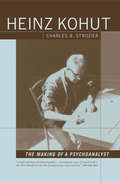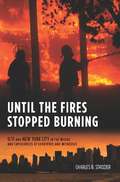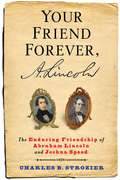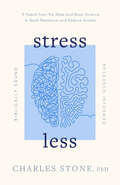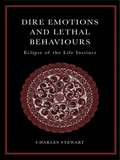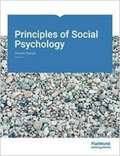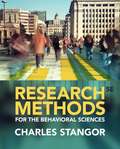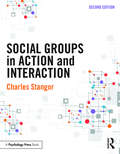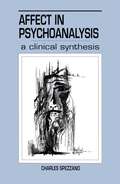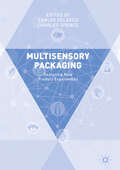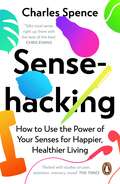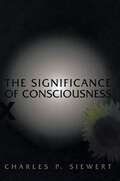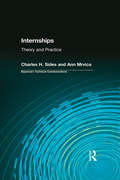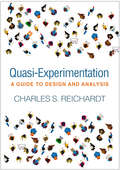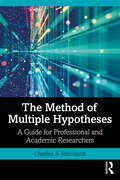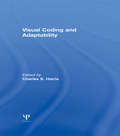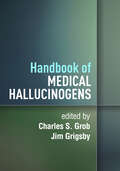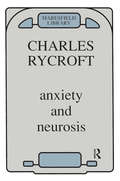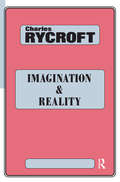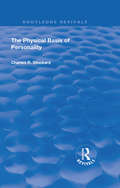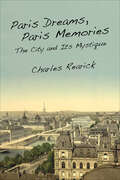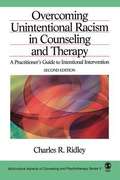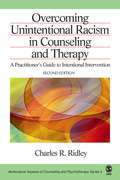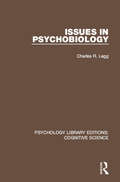- Table View
- List View
Heinz Kohut: The Making of a Psychoanalyst
by Charles StrozierHeinz Kohut (1913-1981) stood at the center of the twentieth-century psychoanalytic movement. After fleeing his native Vienna when the Nazis took power, he arrived in Chicago, where he spent the rest of his life. He became the most creative figure in the Chicago Institute for Psychoanalysis, and is now remembered as the founder of 'self psychology,' whose emphasis on empathy sought to make Freudian psychoanalysis less neutral. Kohut's life invited complexity. He obfuscated his identity as a Jew, negotiated a protean sexuality, and could be surprisingly secretive about his health and other matters. In this biography, Charles Strozier shows Kohut as a paradigmatic figure in American intellectual life: a charismatic man whose ideas embodied the hope and confusions of a country still in turmoil. Inherent in his life and formulated in his work were the core issues of modern America. The years after World War II were the halcyon days of American psychoanalysis, which thrived as one analyst after another expanded upon Freud's insights. The gradual erosion of the discipline's humanism, however, began to trouble clinicians and patients alike. Heinz Kohut took the lead in the creation of the first authentically home-grown psychoanalytic movement. It took an emigre be so distinctly American. Strozier brings to his telling of Kohut's life all the tools of a skillful analyst: intelligence, erudition, empathy, contrary insight, and a willingness to look far below the surface.
Until the Fires Stopped Burning: 9/11 and New York City in the Words and Experiences of Survivors and Witnesses
by Charles StrozierCharles B. Strozier's college lost sixty-eight alumni in the tragedy of 9/11, and the many courses he has taught on terrorism and related topics since have attracted dozens of survivors and family members. A practicing psychoanalyst in Manhattan, Strozier has also accepted many seared by the disaster into his care. In some ways, the grief he has encountered has felt familiar; in other ways, unprecedented. Compelled to investigate its unique character further, he launched a fascinating study into the conscious and unconscious meaning of the event, both for those who were physically close to the attack and for those who witnessed it beyond the immediate space of Ground Zero.Based on the testimony of survivors, bystanders, spectators, and victim's friends and families, Until the Fires Stopped Burning brings much-needed clarity to the conscious and unconscious meaning of 9/11 and its relationship to historical disaster, apocalyptic experience, unnatural death, and the psychological endurance of trauma. Strozier interprets and contextualizes the memories of witnesses and compares their encounter with 9/11 to the devastation of Hiroshima, Auschwitz, Katrina, and other events Kai Erikson has called a "new species of trouble" in the world. Organizing his study around "zones of sadness" in New York, Strozier powerfully evokes the multiple places in which his respondents confronted 9/11 while remaining sensitive to the personal, social, and cultural differences of these experiences. Most important, he distinguishes between 9/11 as an apocalyptic event (which he affirms it is not;rather, it is a monumental event), and 9/11 as an apocalyptic experience, which is crucial to understanding the act's affect on American life and a still-evolving culture of fear in the world.
Your Friend Forever, A. Lincoln: The Enduring Friendship of Abraham Lincoln and Joshua Speed
by Charles StrozierOn April 15, 1837, a "long, gawky" Abraham Lincoln walked into Joshua Speed's dry-goods store in Springfield, Illinois, and asked what it would cost to buy the materials for a bed. Speed said seventeen dollars, which Lincoln didn't have. He asked for a loan to cover that amount until Christmas. Speed was taken with his visitor, but, as he said later, "I never saw so gloomy and melancholy a face." Speed suggested Lincoln stay with him in a room over his store for free and share his large double bed. What began would become one of the most important friendships in American history.Speed was Lincoln's closest confidant, offering him invaluable support after the death of his first love, Ann Rutledge, and during his rocky courtship of Mary Todd. Lincoln needed Speed for guidance, support, and empathy. Your Friend Forever, A. Lincoln is a rich analysis of a relationship that was both a model of male friendship and a specific dynamic between two brilliant but fascinatingly flawed men who played off each other's strengths and weaknesses to launch themselves in love and life. Their friendship resolves important questions about Lincoln's early years and adds significant psychological depth to our understanding of our sixteenth president.
Stress Less: 9 Habits from the Bible and Brain Science to Build Resilience and Reduce Anxiety • Biblically Sound • Research Informed
by Charles StoneWe&’re living in a stressed-out world. According to a poll from the American Psychological Association more than a quarter of U.S. adults say they&’re so stressed they can&’t function. But it&’s not just adults. Teenagers and children are also experiencing the negative effects of stress. Blending brain science, biblical truth, and best practices, Stress Less provides hope and healing. From his PhD research, pastor Charles Stone presents nine actionable insights for those battling stress or who have friends or family with fear and anxiety. Stone writes about biblical characters who successfully and unsuccessfully navigated stress and shares how he&’s responded to the stresses in his life, including a cancer diagnoses, heart issue, pre-diabetes diagnosis, and depression.Stone answers the questions: What is stress?What does stress do to the body and brain?How do we build resistance to stress? He shows how changes in thinking, feeling, sleep, spiritual practices, and relationships can help us thrive through life&’s stresses. Readers learn how gratitude and soaking your soul in Jesus can cultivate a life of greater well-being and joy. While we can&’t eliminate the stressors of life, we can learn to navigate them with courage and grace. This timely resource is a practical guide for anyone who feels the creep of stress, who desires freedom and peace, and who wants to Stress Less.
Dire Emotions and Lethal Behaviours: Eclipse of the Life Instinct
by Charles StewartDire Emotions and Lethal Behaviours explores the primary motivational system in human beings. Based on the work of C. G. Jung, James Hillman, Louis Stewart and Silvan Tomkins, Charles Stewart investigates the psychology of the innate affects, with a focus towards the emotional motivation of adolescents and young adults who have killed others, themselves, or both. It is suggested that social isolation, dissociation of the personality, unbearable emotions, and possession by affects are necessary conditions for both homicide and suicide. Stewart argues that these conditions result from deep-seated emotional psychopathology which involves both the positive affects of the life instinct - Interest and Joy, and the crisis affects - Fear, Anguish, Anger, and Shame/Contempt. Illustrated throughout with case studies of individuals who have committed homicide, suicide, or both, Dire Emotions and Lethal Behaviours aims to discover the emotional motivations for such behaviours so that through education and psychological treatment, such tragic outcomes can be prevented. This book will be of interest to professionals and students in the fields of mental health and criminal justice.
Introduction to Psychology Version 2.1
by Charles StangorIntroduction to Psychology Version 2.1 was collated to help students organize their thinking about psychology at a conceptual level.
Principles of Social Psychology Version 2.0
by Charles StangorWhen purchased from FlatWorld (the publisher), this Color Print Textbook includes Online Access, Quizzes, Flashcards and Homework (if professor uses Homework system). Online textbook is accessible. Principles of Social Psychology is a comprehensive text covering all of the traditional topics. Rather than relying on “modules” or “appendices” of applied materials, Stangor integrates applied concepts to the text itself.
Research Methods for the Behavioral Sciences (Fifth Edition)
by Charles StangorThe author provides succinct explanations for a full range of methods, including descriptive, correlational, experimental, and quasi-experimental research designs.
Social Groups in Action and Interaction: 2nd Edition (Psychology Ser.)
by Charles StangorSocial Groups in Action and Interaction reviews and analyzes the human group as it operates to create both social good and, potentially, social harm. It summarizes current knowledge and contemporary research, with real-world examples in succinct yet engaging chapters, to help students understand and predict group behavior. Unlike other texts, the book considers a wide range of topics--such as conformity, leadership, task performance, social identity, prejudice, and discrimination--from both an intragroup and an intergroup perspective. By looking at behavior both within and between groups, it bridges the gap between these interconnected approaches. The second edition is thoroughly updated to include new discussion of the biology and neuroscience of group formation, recent developments in social identity theory, and recent advances in the study of social networks. It also includes questions for review and discussion in the classroom. It provides the most comprehensive and essential resource for courses on group dynamics and behavior.
Affect in Psychoanalysis: A Clinical Synthesis (Relational Perspectives Book Series)
by Charles SpezzanoDrawing on the writings of Freud, Fairbairn, Klein, Sullivan, and Winnicott, Spezzano offers a radical redefinition of the analytic process as the intersubjective elaboration and regulation of affect. The plight of analytic patients, he holds, is imprisonment within crude fantasy elaborations of developmentally significant feeling states. Analytic treatment fosters the patient's capacity to keep alive in consciousness, and hence reflect on, these previously warded-off affective states; it thereby provides a second chance to achieve competence in using feeling states to understand the self within its relational landscape.
Multisensory Packaging: Designing New Product Experiences
by Charles Spence Carlos VelascoThis edited collection presents state-of-the-art reviews of the latest developments in multisensory packaging design. Bringing together leading researchers and practitioners working in the field, the contributions consider how our growing understanding of the human senses, as well as new technologies, will transform the way in which we design, interact with, and experience food and beverage, home and personal care, and fast-moving consumer products packaging. Spanning all of the senses from colour meaning, imagery and font, touch and sonic packaging, a new framework for multisensory packaging analysis is outlined. Including a number of case studies and examples, this book provides both practical application and theoretical discussion to appeal to students, researchers, and practitioners alike.
Sensehacking: How to Use the Power of Your Senses for Happier, Healthier Living
by Charles SpenceThe world expert in multisensory perception on the remarkable ways we can use our senses to lead richer lives 'Talks total sense, lots of fun facts, right up there with the best of the best' Chris Evans'Packed with studies on pain, attention, memory, mood' The Times How can the furniture in your home affect your wellbeing? What colour clothing will help you play sport better? And what simple trick will calm you after a tense day at work? In this revelatory book, pioneering and entertaining Oxford professor Charles Spence shows how our senses change how we think and feel, and how by 'hacking' them we can reduce stress, become more productive and be happier.We like to think of ourselves as rational beings, and yet it's the scent of expensive face cream that removes wrinkles (temporarily), a room actually feels warmer if you use a warmer paint colour, and the noise of the crowd really does affect the referee's decision. Understanding how our senses interact can produce incredible results. This is popular science at its unbelievable best. 'Spence does for the senses what Marie Kondo does for homes' Avery Gilbert, author of What the Nose Knows 'Everything you need to know about how to cope with the hidden sensory overload of modern life, engagingly told' Robin Dunbar, author of How Many Friends Does One Person Need?
The Significance of Consciousness
by Charles SiewertCharles Siewert presents a distinctive approach to consciousness that emphasizes our first-person knowledge of experience and argues that we should grant consciousness, understood in this way, a central place in our conception of mind and intentionality. Written in an engaging manner that makes its recently controversial topic accessible to the thoughtful general reader, this book challenges theories that equate consciousness with a functional role or with the mere availability of sensory information to cognitive capacities. Siewert argues that the notion of phenomenal consciousness, slighted in some recent theories, can be made evident by noting our reliance on first-person knowledge and by considering, from the subject's point of view, the difference between having and lacking certain kinds of experience. This contrast is clarified by careful attention to cases, both actual and hypothetical, indicated by research on brain-damaged patients' ability to discriminate visually without conscious visual experience--what has become known as "blindsight." In addition, Siewert convincingly defends such approaches against objections that they make an illegitimate appeal to "introspection." Experiences that are conscious in Siewert's sense differ from each other in ways that only what is conscious can--in phenomenal character--and having this character gives them intentionality. In Siewert's view, consciousness is involved not only in the intentionality of sense experience and imagery, but in that of nonimagistic ways of thinking as well. Consciousness is pervasively bound up with intelligent perception and conceptual thought: it is not mere sensation or "raw feel." Having thus understood consciousness, we can better recognize how, for many of us, it possesses such deep intrinsic value that life without it would be little or no better than death.
Internships: Theory and Practice (Baywood's Technical Communications)
by Charles Sides Ann Mrvica"Internships: Theory and Practice" focuses on the history, theory, value, design, administration, and evaluation of professional internships as an educational experience for college students. Internships are guided, pre-professional experiences that combine academic and professional components as a managed transition to professional careers. Touted by many as an educational innovation for the 21st century, internships (or experiential learning, or apprenticeships, as they once were called) have been a staple of professional preparation for centuries, dating back at least to the earliest documentation in the Middle Ages and no doubt far beyond that.Charles Sides and Ann Mrvica trace this history through primary sources to explore the development of internship experiences over the past 800 years, create an introduction to the topic of internships, and provide a foundation for modern college-corporation partnerships in professional education and training. The authors present specific guidelines and discussions on issues important to corporations, in terms of providing for internship experiences; issues important to colleges, in terms of designing and evaluating internships; and issues important to students, in terms of participating in and learning from internships.
Quasi-Experimentation: A Guide to Design and Analysis (Methodology in the Social Sciences)
by Charles S. ReichardtFeaturing engaging examples from diverse disciplines, this book explains how to use modern approaches to quasi-experimentation to derive credible estimates of treatment effects under the demanding constraints of field settings. Foremost expert Charles S. Reichardt provides an in-depth examination of the design and statistical analysis of pretest–posttest, nonequivalent groups, regression discontinuity, and interrupted time-series designs. He details their relative strengths and weaknesses and offers practical advice about their use. Comparing quasi-experiments to randomized experiments, Reichardt discusses when and why the former might be a better choice than the latter in the face of the contingencies that are likely to arise in practice. Modern methods for elaborating a research design to remove bias from estimates of treatment effects are described, as are tactics for dealing with missing data and noncompliance with treatment assignment. Throughout, mathematical equations are translated into words to enhance accessibility. Adding to its discussion of prototypical quasi-experiments, the book also provides a complete typology of quasi-experimental design options to help the reader craft the best research design to fit the circumstances of a given study.
The Method of Multiple Hypotheses: A Guide for Professional and Academic Researchers
by Charles S. ReichardtThis book illustrates the method of multiple hypotheses with detailed examples and describes the limitations facing all methods (including the method of multiple hypotheses) as the means for constructing knowledge about nature. Author Charles Reichardt explains the method of multiple hypotheses using a range of real-world applications involving the causes of crime, traffic fatalities, and home field advantage in sports. The book describes the benefits of utilizing multiple hypotheses and the inherent limitations within which all methods must operate because all conclusions about nature must remain tentative and forever subject to revision. Nonetheless, the book reveals how the method of multiple hypotheses can produce strong inferences even in the face of the inevitable uncertainties of knowledge. The author also explicates some of the most foundational ideas in philosophy of science including the notions of the underdetermination of theory by data, the Duhem-Quine thesis, and the theory-ladenness of observation. This book will be important reading for advanced undergraduates, graduates, and professional researchers across the social, behavioral, and natural sciences wanting to understand this method and how to apply it to their field of interest.
Visual Coding and Adaptability
by Charles S. HarrisFirst published in 1980. This book is the first integrated presentation of two of the most active areas in present-day visual research. Its inspiration and nucleus were provided by two Optical Society of America symposia, one on the coding of spatial information in the visual system and the other on adaptability of the visual system. Although the two topics might seem, at first sight, only distantly related, they are actually extensively intertwined in contemporary research. Some investigators focus on mechanisms of visual analysis but rely on experimental modification of perception to reveal the nature of the coding; others focus on perceptual modification but look at analytic elements for indications about what it is that gets modified. Likewise, most of the chapters in this book combine, in varying proportions, both themes. Adult human perception is the primary concern, but illuminating data from animal, infant, and neurophysiological studies are also discussed.
Handbook of Medical Hallucinogens
by Charles S. Grob and Jim GrigsbyThis handbook reviews promising applications of psychedelics in treatment of such challenging psychiatric problems as posttraumatic stress disorder, major depression, substance use disorders, and end-of-life anxiety. Experts from multiple disciplines synthesize current knowledge on psilocybin, MDMA, ketamine, and other medical hallucinogens. The volume comprehensively examines these substances' neurobiological mechanisms, clinical effects, therapeutic potential, risks, and anthropological and historical contexts. Coverage ranges from basic science to practical clinical considerations, including patient screening and selection, dosages and routes of administration, how psychedelic-assisted sessions are structured and conducted, and management of adverse reactions.
Anxiety and Neurosis (Maresfield Library)
by Charles RycroftAnxiety may be debilitating or stimulating; it can result in neurotic symptoms or in improved, heightened performance in an actor or athlete. It is something every human being has experienced. As Professor G. M. Carstairs points out in his Foreword: 'During the course of the twentieth century we have found it progressively easier to concede that we are all to often swayed by emotion rather than reason. We have come to recognize the symptoms of neurotically ill patients are only an exaggeration of experiences common to us all, and hence that the unraveling of the psychodynamics of neurosis can teach us more about ourselves'. Although Charles Rycroft is also a psychoanalyst, it is as a biologist that he has made this study of anxiety, the three basic responses to it - attack, flight or submission - and the obsessional, phobic and schizoid and hysterical defenses. Written in precise but everyday language, Anxiety and Neurosis is based on adult experiences rather than the speculative theories of infantile instinctual development. Its clarity and authority can only add to Dr Rycroft's established international reputation.
Imagination and Reality: Psychoanalytical Essays 1951-1961 (Maresfield Library)
by Charles RycroftA collection of essays, introduced by Masud Khan and J.D. Sutherland, on a variety of subjects including: observations on a case of vertigo; on idealization, illusion, and catastrophic disillusion; the nature and function of the analyst's communication to the patient; beyond the reality principle; and, the analysis of a detective story.
Revival: The Physical Basis Of Personality (1931) (Routledge Revivals)
by Charles Rupert StockardAn outcome of the 1930 series of Lane Medical Lectures at Stanford University. To develop the completed personality a long series of interactions between the original basis and the surrounding environment is essential. A discussion of the effects on developing personalities of uniting entire individuals and of transplanting organs and parts leads to a convincing demonstration of the "high improbability of the inheritance of acquired characters." From the chapter on exaggerated deviations from racial types, in which the author treats of dwarfs and giants, we are led into a section on deviations in structural types among various breeds of dogs. The closing chapters treat mainly of the two normal adult types, the dolichocephalic (linear, long-headed) and the brachycephalic (lateral, short-headed), their characteristics, geographic distribution and age modifications. A brief section is devoted to the sex glands, senility and rejuvenation, the author demonstrating that the sex gland rejuvenation idea is based upon an entirely erroneous conception. Man's deviation from his nearest animal relatives, namely, intellectual achievement, has probably been initiated by two evolutionary changes: (1) some mutation which has resulted in the retention of head proportions comparable to those found in the fetal stages of the higher mammals: this gives a disproportionately large cranium and big brain with small facial region as compared to the reverse adult proportions among other mammals; (2) a germinal mutation resulting in an exaggerated prolongation of childhood and the stages of immaturity to more than twenty years, thus extending enormously the learning period of man. There are considerable experimental material, over seventy figures, and a bibliography of 260 titles.
Paris Dreams, Paris Memories: The City and Its Mystique
by Charles RearickRearick (emeritus, history U. of Massachusetts, Amherst) presents this history of Paris in the last one hundred and fifty years, an examination of the creation and recreation of the city and the effect of this continual rebirth on its people and its image at home and abroad. The work presents a discussion of the way in which attachment to tradition has conflicted and cooperated with the evolution of the city through crisis, destruction and the tests of time focusing on the nineteenth century foundations of modern Paris, the lingering memories of the Bell Epoque, post war modernization and "Nouveau Paris" of the late twentieth century. The volume includes numerous black and white photographs as well as a time line of modern Paris and appendices on unique features and landmark imagery. Annotation ©2011 Book News, Inc., Portland, OR (booknews.com)
Overcoming Unintentional Racism in Counseling and Therapy: A Practitioner's Guide to Intentional Intervention
by Charles R. RidleyDiscusses how individuals can learn how to confront their racist attitudes and become allies.
Overcoming Unintentional Racism in Counseling and Therapy: A Practitioner′s Guide to Intentional Intervention (Multicultural Aspects of Counseling series)
by Charles R. RidleyAny counselor or therapist, regardless of race, background, or motive, can engage in unintentional acts of racism. In so doing, they may inadvertently sabotage their own efforts and perpetuate the very problems they seek to overcome. Overcoming Unintentional Racism in Counseling and Therapy, Second Edition examines the dynamics and effects of racism in counseling with an emphasis on the insidiousness of unintentional racism. Workable solutions and practical alternatives are proposed with the goal of eliminating unintentional racism. Numerous supporting clinical examples are included in order to help counselors gain new insights into their operational practices and to modify any behaviors that may interfere with a helpful intervention. The Second Edition also provides a new section on the policies and practices of agencies and other institutions in the mental health system unintentionally resulting in service disparities. Macro-system and micro-system interventions are proposed to overcome these disparities. Key Features: The only book that addresses unintentional racism in counseling and therapy. Offers a superb balance of theory and practice. Provides problem identification and workable solutions to individual and institutional racism. Overcoming Unintentional Racism in Counseling and Therapy is ideally suited as a supplemental text for theoretical courses in counseling, counseling techniques, practicum, multicultural counseling, and professional seminars.
Issues in Psychobiology (Psychology Library Editions: Cognitive Science)
by Charles R. LeggAt the time of original publication psychobiology was one of the most rapidly developing areas of psychology. Its growth owed much to recent advances both in techniques for studying the physiological bases of behaviour and in major conceptual advances in the way people thought about the brain. First published in 1989, this textbook introduction to the field looks at the state of psychobiology in the light of these advances. The issues covered include: the factors that have shaped the current state of the field; the value of animal subjects in the study of psychological processes; the problems of studying the brain, including the theoretical assumptions underlying the most widely used methods; the current status of influential theories, like Stellar’s 2-center theory of motivation and Papez’s theory of emotion; the relationship between psychological theory and physiological data, such as recent accounts of the visual system; the problems presented by ‘emergent properties’ like consciousness.
